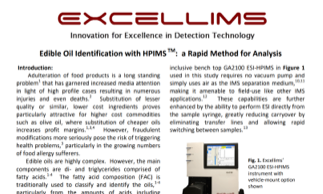Chemical Contamination of Food: Analysis of Edible Oils
 Substitution of lesser quality or similar, lower cost ingredients proves particularly attractive for higher cost commodities such as olive oil, where substitution of cheaper oils increases profit margins. Edible oils are highly complex. Different techniques have been applied to analyzing edible oils and fatty acids, including high-performance liquid chromatography (HPLC) with UV and mass spectrometry (MS) detection, gas chromatography (GC) with derivativization, Fourier transform infrared (FTIR) spectroscopy, and direct electrospray ionization ESI-MS. These methods are increasingly being combined with chemometrics such as principle component analysis (PCA) to elucidate the more subtle differences in the different oil profiles to enhance the identification process. However, High-performance Ion Mobility Spectrometry (HPIMS) has recently been shown to provide fast, sensitive detection of food additives and contaminants such as phthalates, food grade and illicit dyes, and artificial sweeteners with total sample analysis times of < 1 minute even in food matrices
Substitution of lesser quality or similar, lower cost ingredients proves particularly attractive for higher cost commodities such as olive oil, where substitution of cheaper oils increases profit margins. Edible oils are highly complex. Different techniques have been applied to analyzing edible oils and fatty acids, including high-performance liquid chromatography (HPLC) with UV and mass spectrometry (MS) detection, gas chromatography (GC) with derivativization, Fourier transform infrared (FTIR) spectroscopy, and direct electrospray ionization ESI-MS. These methods are increasingly being combined with chemometrics such as principle component analysis (PCA) to elucidate the more subtle differences in the different oil profiles to enhance the identification process. However, High-performance Ion Mobility Spectrometry (HPIMS) has recently been shown to provide fast, sensitive detection of food additives and contaminants such as phthalates, food grade and illicit dyes, and artificial sweeteners with total sample analysis times of < 1 minute even in food matrices